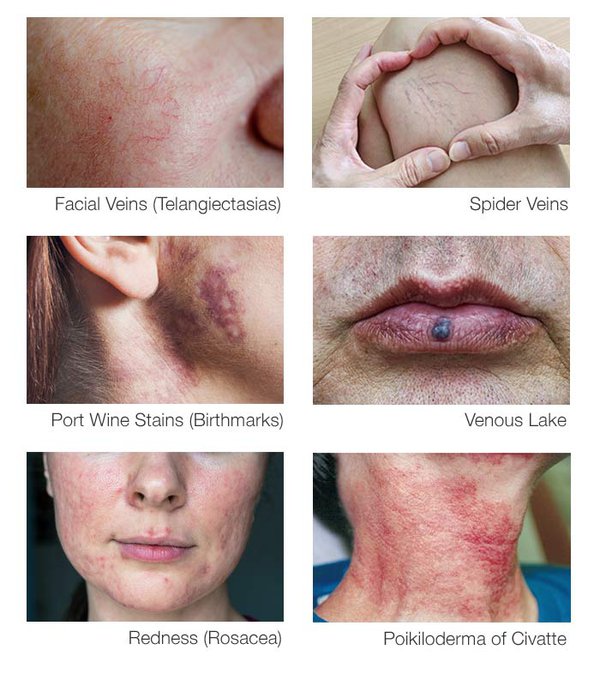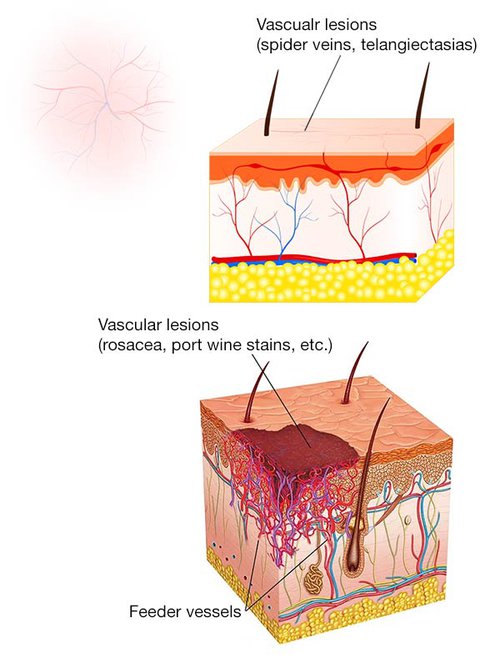Skin discoloration might stop you from feeling as confident as you want to feel. If you are feeling self-conscious about your vascular skin lesions, you may be wondering how you can remove a prominent birthmark or reduce the appearance of veins to help you feel and look your best.

Vascular lesions are patches of skin that look red, blue, or purple, caused by ruptured blood vessels under the skin. Vascular lesions on your skin may be present at birth or can develop later in life. Most of the time, vascular lesions don’t need medical treatment.1
You can be born with many types of vascular lesions, which is why they are commonly referred to as birthmarks. It is common for the appearance of these lesions to change over time. Port wine stains, also known as nevus flammeus, are an example of a flat vascular lesion of the skin.1
Rosacea or facial redness, is a chronic condition that sometimes is misidentified as acne. Rosacea is not contagious, it is a life long condition and if it left un-treated, it can be spread and causes burning sensation in the affected areas.
You may notice small, red lines on your face and legs, sometimes referred to as spider veins. This can happen when the small capillaries under the skin bulge or enlarge. Veins can appear through the skin on anyone, but some people are more likely to have spider veins3 than others.
It is possible to remove or decrease the look of vascular birthmarks with treatments. Lightening a birthmark by 70 to 90 percent is a realistic goal for most people. Some vascular skin lesions and cafe au lait birthmarks can be treated to appear normal.2
A vascular condition such as Telangiectasias (spider veins) is the result of abnormally dilated blood vessels just below your skin. These tiny blood vessels in the top layers of the skin become swollen from blood pooling, causes them to rip, which leads to more spider veins forming, also known as broken capillaries.
The tiny blood vessels in telangiectasias are fragile and are easy to damage with anything that increases pressure on them. The common areas for spider veins are face and lower legs: sun exposure can damage your blood vessels on the skin surface of the face, and gravity naturally causes blood to pool to the lower legs.
Some factors that can increase the risk of spider veins are: aging, medical conditions such as chronic venous insufficiency and chronic liver disease, drinking alcohol, pregnancy, genetics, sun exposure, injuries, increased pressure like vomiting or sneezing.
Rosacea is also a common type of vascular lesion. Rosacea is characterized by redness on the face, it can affect the eyes, causing eye dryness, itching, swollen red eyelids. Rosacea can thicken the skin on the forehead, cheeks, nose, chin, and ears. Together with skin thickening, pores are enlarged showing bumpy red looking texture on the skin surface. Common causes of rosacea are: stress, allergies, sun exposure, unhealthy diet, hormone imbalances.

Prescribed antibiotics can be used to treat bacteria that cause acne and inflammatory skin, but it does not help with rosacea. Topical cream contains azelaic acid and niacinamide can be prescribed by a dermatologist, azelaic acid and niacinamide might help to reduce redness and pimples associated with rosacea. Please always follow your doctor's direction of use on topical medications.
Vascular skin lesions can be treated with lasers in the doctor office. There are procedures that can help improve the look of many kinds of vascular conditions, such as: rosacea/redness, benign vascular lesions, spider veins, facial veins, leg veins, port wine stains, venous lakes, poikiloderma of civatte.
Laser treatments use focused light from a laser to shrink the tiny blood vessels below the skin, reduce the appearance of vascular lesions. Lasers can precisely target4 the vascular lesion without damaging the surrounding area.4 Candela’s Gentle™ Family of lasers use short pulses of light energy to target and destroy problematic blood vessels under the surface of the skin. Before and after each laser pulse, a liquid coolant is released onto the skin, protecting the surrounding tissue, and reducing discomfort from the laser pulses. This cooling system can be adjusted to your individual needs.
Pulsed dye lasers (PDLs) target blood vessels under the skin using a concentrated beam of yellow light. The blood vessel is destroyed when the light is converted into heat.5 Candela's Vbeam® PDL system delivers an intense but gentle burst of light into targeted areas of the affected skin. The light is absorbed by the blood vessels to remove targeted imperfections.
Intense pulsed light (IPL) uses short bursts of light to heat your skin to destroy the blood vessels in the lesion. Your body will heal itself and cut off these vessels, so the lesion does not come back.
Candela's Nordlys® Selective Waveband Technology (SWT®) IPL system for vascular lesion therapy uses multiple wavelengths of light, so it can be used to treat different skin conditions at the same time.6
There are some steps you should take to get the best result from your laser treatment:7
You should notice results right away for small veins. It may take a few weeks for the appearance of larger veins to fade. Taking care of the affected area is important after treatment:7,8
It is possible to improve the look of your skin and improve your confidence with laser treatments. Birthmarks are treatable and can be lightened by up to 70 to 90 percent. Laser treatment is non-invasive, and pain and discomfort during and after treatment are minimal.7 Treatments can be repeated every three months until you are happy with the results.
As with all treatments, there are some risks associated with laser treatment. These risks are greatly decreased when the procedure is done by a qualified professional.7 The risks include: pain, swelling, bleeding, infection, scarring, crusting, changes in skin color.